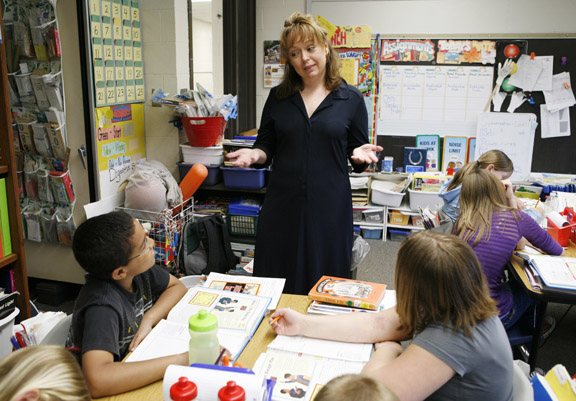
Della Kemper helps 4th-grade student Chase Gilbert with fire safety questions during Kemper’s health class at Miles Elementary School (Erlanger-Elsmere Independent) April 26, 2010. Miles Elementary is going into its second year using a standards-based grading system that replaces traditional grades A-D and F with standards set by teachers and students.
Photo by Amy Wallot
By Matthew Tungate
For the second year in a row, students at Miles Elementary School (Erlanger-Elsmere Independent) won’t receive grades.
Yet teachers and the principal say students and their parents are better informed about what the children know – and what skills and information they still need to master.
Bryant Gillis, in his seventh year as principal, said he never figured out in his 36 years in education what an A really means.
“As a parent, you could get an A student coming home without knowing any of the skills necessary to support that A,” he said.
So Miles Elementary has replaced traditional grades A-D and F with standards set by teachers and students. Each grade level has standards that students are required to meet, which then lead into the standards required for the next grade. To measure progress toward meeting the standards, students fall into four categories: Exceeds Mastery, Mastery, Partial Mastery and Non-Mastery. The teachers use rubrics they designed to measure students’ progress, and they continue working with students until they reach mastery.
Kim Asbrock, a 4th-grade teacher in her ninth year, said she remembers parents would get upset that student got a bad grade.
“And I was like, they don’t need to be upset because they have a bad grade. They need to be upset because their child can’t add or multiply or read,” she said. “So I really felt like they were missing the point.”
Even though she sees the value, Asbrock said giving up traditional grades has been uncomfortable.
“When you’re a teacher, you have a grade book and grades, and you write them down and average them up,” she said. “Letting go of that was probably the most challenging part for me.”
Della Kemper, a 4th-grade teacher in her 16th year, said she always felt like grades were a reward or a punishment – not a measure of what a student knows.
“We just couldn’t keep making our students feel like they were being punished for not knowing something,” she said. “I felt like it never really told them where they were and what they could improve on.
“I never liked grades.”
As part of the new standards-based grading system, teachers keep and analyze a lot of data on students. Asbrock said those profiles help the teachers look beyond the percentage of answers a student got right to which ones and why.
“You think that a child is failing, and then when you look at it you’re like, ‘Gosh, he knows six out of the seven standards. He just missed all of the questions on this one,’” she said. “So sometimes it’s kind of comforting because you think he’s really struggling and then you’re like, ‘We just need to work on this one thing.’”
So teachers still assess students, Kemper said, but “what we do with that assessment is different.”
“The difficult part for me was that in a standards-based assessment, you’re never done until that child has mastered that goal,” she said. “If they didn’t master it, there’s a lot of follow up.”
Teachers are able to provide remediation (and enrichment to students who want to exceed mastery) because the school had already changed its schedule to include blocks of time for the extra help.
Gillis said the 2009-10 school year was the first in which the school did not give grades on report cards. That was the culmination of four years of using some of the most cutting-edge techniques in education, including professional learning communities, learning targets, standards-based instruction and following the gospel of education gurus Richard and Rebecca DuFours, Robert Marzano, and Rick Stiggins.
Gillis said the movement at Miles Elementary began in 2006 when he heard the DuFours, Marzano and Stiggins speak. He had teachers look at curriculum alignment, SMART goals and objectives, and what were the precursors to learning communities.
The following summer (2007), he took three teachers – including Kemper – to hear the DuFours and Stiggins.
“On the way back, there was never a moment of silence on the school bus,” Gillis said. “They said, ‘We’ve got to change it. Things have got to happen, and Mr. Gillis, we’re going to do this.’”
The three teachers contacted the other faculty members, made a master schedule and wrote in time for the interventions.
In 2008-09, teachers developed learning targets and common assessments, and the district realigned curriculum for all four elementary schools, Gillis said.
So leading into the 2009-10 school year, teachers met vertically to develop and align standards that Gillis says have “more rigor than an A or a B ever had. Our standards are higher.”
At the same time, Gillis said he was meeting with parent groups and giving them homework. Parents read and learned about standards-based curriculum and assessment. He held two parent academies to tell parents how the grading system would work.
Parents thought it was good, he said, but they had “a bunch of questions.” So he showed an example of what the report card would look like and explained why standards-based curriculum and assessment is better.
“We felt so committed that we had to make changes, that they felt that with us,” he said.
Gillis said he didn’t receive any negative feedback from parents when the first report cards went out, either.
He acknowledges that the new report cards, which take about 30 minutes each, take more work than traditional grading systems. Any schools that move to standards-based curriculum and instruction must give teachers the time to meet with each other and evaluate data to personalize instruction.
But, he said, it’s worth it.
“You can’t sit back just because people are uncomfortable with change,” Gillis said. You have to endorse change, and you have to let people know that a change is okay.”
MORE INFO…
www.erlanger.k12.ky.us/miles
Bryant Gillis, bryant.gillis@erlanger.kyschools.us, (859) 727-2231




Leave A Comment